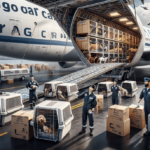Importance of Properly Shipping Live Animals
Shipping live animals is a complex process that requires meticulous planning and attention to detail to ensure the safety and well-being of the animals. Proper shipping practices are essential not only for the welfare of the animals but also for maintaining compliance with various legal and environmental regulations. This comprehensive guide explores the critical aspects of shipping live animals, highlighting best practices and the role of reliable carriers like UPS in facilitating safe transportation.
Risks and Challenges in Transporting Live Animals
Health and Welfare Concerns
Transporting live animals poses significant health risks, including exposure to extreme temperatures, dehydration, and stress-induced illnesses. Animals can become injured if not properly secured or if exposed to adverse environmental conditions during transit.
Environmental Impact
Accidental release of invasive species during transport can disrupt local ecosystems. Ensuring secure containment and adhering to environmental guidelines are crucial to prevent such incidents.
Legal and Regulatory Requirements for Animal Shipping
International Regulations
Shipping live animals internationally involves navigating a myriad of regulations set by bodies like the International Civil Aviation Organization (ICAO) and the United Nations Economic Commission for Europe (UNECE). Compliance with these regulations is mandatory to avoid legal repercussions.
Necessary Documentation and Permits
Essential documents include health certificates, import/export permits, and animal welfare declarations. The specific requirements vary based on the animal type and destination country. Failure to obtain the necessary documentation can lead to shipment delays or refusals.
Effective Packaging and Climate Control Techniques
Packaging Materials and Design
Proper packaging is vital to protect animals from external elements and to ensure their comfort. Containers should be made of non-toxic, moisture-resistant materials and provide adequate space for movement.
Temperature and Climate Control
Maintaining optimal temperature and humidity levels during transit is crucial. Utilizing temperature-controlled vehicles and providing adequate ventilation can prevent heat stress and hypothermia in animals.
Preparing Animals for Transit
Veterinary Check-ups
Before shipping, animals should undergo thorough veterinary examinations to ensure they are fit for travel. Vaccinations and health clearances may be required depending on the destination.
Acclimatization to Transport Containers
Familiarizing animals with their transport containers prior to shipping can reduce stress and anxiety during transit. Including familiar scents and bedding can enhance their comfort.
Choosing the Right Logistics Partner
Benefits of Using UPS
UPS offers specialized services for shipping live animals, including customized packaging solutions and temperature-controlled shipping options. Their expertise ensures compliance with all regulatory requirements, providing a seamless and safe shipping experience.
Tips for Selecting a Carrier
- Experience with live animal transport
- Availability of temperature and climate control options
- Compliance with international and local regulations
- Positive customer reviews and testimonials
Common Mistakes and How to Avoid Them
- Inadequate Preparation: Failing to prepare animals and their containers properly can lead to increased stress and health issues.
- Poor Documentation: Ensuring all required permits and health certificates are in order is essential to prevent legal complications.
- Improper Packaging: Using unsuitable materials or insufficient space in containers can harm the animals during transit.
- Neglecting Climate Control: Ignoring temperature and humidity requirements can result in severe health risks for the animals.
Ensuring the Welfare of the Animal during Transit
The welfare of animals during shipping encompasses providing adequate food, water, ventilation, and space. Minimizing stress through a quiet and comfortable environment is essential. Employing experienced animal handlers can further ensure the animals' well-being throughout the transportation process.
Conclusion
Shipping live animals requires a comprehensive understanding of the associated risks, legal requirements, and best practices for packaging and climate control. Partnering with experienced carriers like UPS can significantly enhance the safety and efficiency of the shipping process, ensuring that animals arrive at their destinations healthy and unharmed. By adhering to these guidelines and avoiding common pitfalls, successful and humane transportation of live animals can be achieved.




















